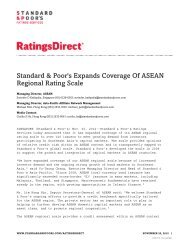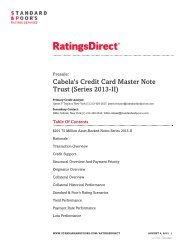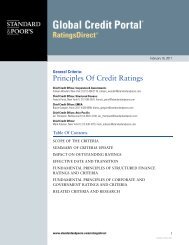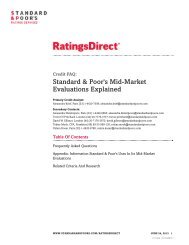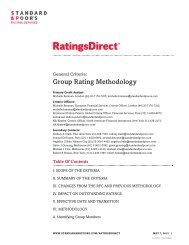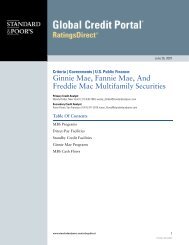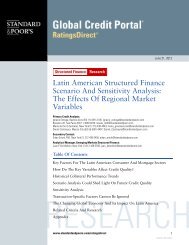Criteria for Rating German Residential Mortgage ... - Standard & Poor's
Criteria for Rating German Residential Mortgage ... - Standard & Poor's
Criteria for Rating German Residential Mortgage ... - Standard & Poor's
You also want an ePaper? Increase the reach of your titles
YUMPU automatically turns print PDFs into web optimized ePapers that Google loves.
expenses. This amount depends on the size of the transaction, and can be modeled either as a separate contingency<br />
reserve or a haircut to the reserve fund, or can be addressed through an appropriate guarantee.<br />
Substitution of Assets<br />
Some transactions allow <strong>for</strong> the substitution of mortgage loans as the original mortgage loans repay. In order to<br />
ensure that the credit quality of the portfolio does not deteriorate, a substitution model has been developed <strong>for</strong> use<br />
by originators. This model should be run <strong>for</strong> each substitution to ensure that the level of credit enhancement remains<br />
sufficient.<br />
<strong>Criteria</strong> Structured Finance RMBS: <strong>Criteria</strong> <strong>for</strong> <strong>Rating</strong> <strong>German</strong> <strong>Residential</strong> <strong>Mortgage</strong>-Backed Securities<br />
Additional requirements include a limitation on how many loans may be substituted in any one quarter (10% of<br />
principal outstanding), a cap on the proportion of delinquencies on the existing pool (cannot exceed 2% of principal<br />
outstanding), and a restriction on the proportion of the first loss tranche used to cover losses (no more than 25%).<br />
Documentation Aspects of Synthetic RMBS Transactions<br />
Given that a high proportion of <strong>German</strong> RMBS transactions are synthetic transactions, a number of important<br />
documentation issues are highlighted below.<br />
Definition of Losses<br />
In synthetic transactions, losses can be divided into principal losses, interest losses, and losses associated with<br />
<strong>for</strong>eclosure costs. It is also possible to differentiate between losses occurring on the balances of the loans to be<br />
securitized, and the same losses occurring on prior-ranking loans that are not included in the securitization.<br />
It is important that the documentation clearly specify which risks are being transferred. The originator sets the<br />
definition of losses arising from the reference pool <strong>for</strong> which it is seeking credit protection. There<strong>for</strong>e, the loss<br />
definitions can differ from one transaction to another. While the definition of losses can be tailored <strong>for</strong> the reference<br />
pool, it is not possible to do this <strong>for</strong> prior-ranking loans that are not in this pool.<br />
Accordingly, <strong>Standard</strong> & <strong>Poor's</strong> needs to know the prior-ranking balances, held with third party banks or the<br />
originator (or both), to be able to calculate losses which will occur on these prior-ranking balances. In addition, the<br />
allocation of recoveries in the synthetic waterfall needs to reflect the degree to which accrued interest and<br />
<strong>for</strong>eclosure costs have been excluded from the loss definition. If these items have been excluded, then they must rank<br />
junior in the waterfall.<br />
Conditions <strong>for</strong> Loss Allocations<br />
The conditions under which losses are allocated are key in synthetic transactions. The trustee's plausibility check of<br />
transaction reports, its audits of loans that lead to losses (eligibility criteria, credit and collections procedures, and<br />
servicing practices, as determined in the offering circular), and the timing of loss allocations are regarded as crucial.<br />
In addition, the scope of the audits with respect to the eligibility criteria, credit collection policies, and other<br />
servicing requirements is considered to have a crucial effect on the transaction.<br />
Extension Risk<br />
<strong>German</strong> repayment mortgage loans allow certain terms of the mortgage, namely the interest rate and the<br />
amortization rate, to be renegotiated at the refix (renewal) date. If the borrower renegotiates amortization rates at<br />
the refix date, this can extend the final maturity of the mortgage loan.<br />
www.standardandpoors.com/ratingsdirect 13<br />
867630 | 300323561




